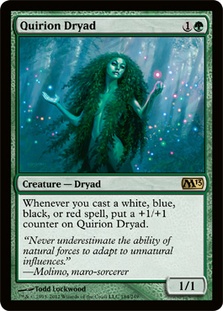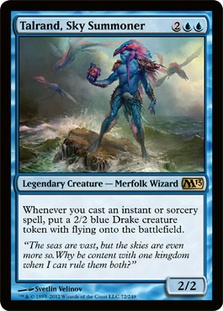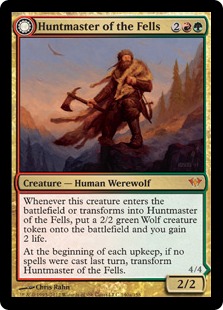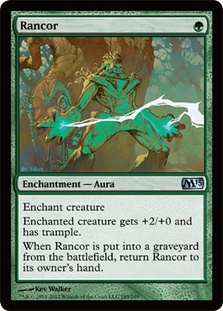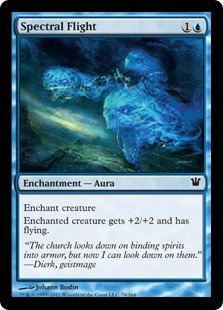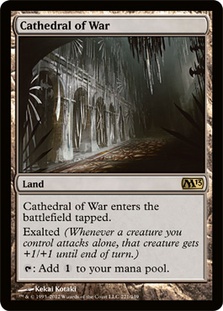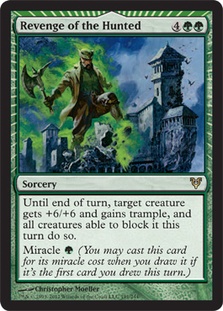M13 was released on Magic Online few days ago, so our knowledge about Standard is not limited to analyzing results of SCG Standard Opens anymore. Magic Online Standard Daily Events have highlighted sweet brews which were not successful in St. Louis, Las Vegas, and Buffalo for some reasons (probably because of deficit of tuning). Nevertheless, many great decks in Magic’s history were not invented immediately (remember the possibility of Caw-Blade at Worlds in 2010?) or were not generally accepted before their champions’ success (like Todd Anderson and his Illusions, which became Delver many months later), or were forced to wait for the appropriate metagame. So let’s look at two cards which have not been as successful as expected: Quirion Dryad and Cathedral of War.
One of the most interesting cards to underperform at SCG Standard Opens after initial high hopes is Quirion Dryad. Todd Anderson recently wrote about U/G and RUG Quirion Dryad decks; Magic Online Daily Events have provided different variants of the Gro idea.
The main source of controversy among RUG Dryad players is the four-drop of choice. While Todd advocates Talrand, Sky Summoner, other players are looking to good ol’ Huntmaster of the Fells. Both cards are 2/2s for four, both produce other 2/2s, and both require casting spells. The difference is evasion versus life gain and removal, so Talrand suggests aggressive play whereas Huntmaster provides versatility. Look at the Huntmaster deck used by Russian grinders Emperok and Butakov:
Creatures (16)
Lands (21)
Spells (23)
- 2 Mana Leak
- 4 Ponder
- 1 Mutagenic Growth
- 4 Gitaxian Probe
- 3 Vapor Snag
- 1 Dismember
- 1 Gut Shot
- 1 Thought Scour
- 3 Bonfire of the Damned
- 3 Pillar of Flame
Sideboard

While Emperok used almost same spell package as Todd, he had three Cavern of Souls, which are, in my opinion, necessary due to Delver’s continuing dominance. What I dislike is four Huntmaster of the Fells—versatility doesn’t mean "overloading a 21-land deck with four-mana creatures," especially with three Thought Scours less than a twelve-cantrip set. The pre-M13 RUG deck was more controllish, and I feel that I’d rather be more aggressive with the addition of Quirion Dryad and maybe even avoid both Talrand and Huntmaster in favor of more aggressive and cheaper creatures. Luckily, I’m not the only person thinking this way.
Creatures (16)
Lands (20)
Spells (24)

Lewis Laskin found a very elegant way to grow Quirion Dryad aggressively. Porcelain Legionnaire is unfortunately weak to Gut Shot, but he is excellent in any other case and does not required colored mana (which is important too). Lewis still has a Talrand in his deck, while I’d rather use some Rancors.
Creatures (16)
Lands (20)
Spells (24)

Ozryel played to 4-0 in a Daily Event with an interesting deck: "classic" U/W Delver splashing green for Quirion Dryad and Rancor. Geist of Saint Traft is an interesting idea for Quirion Dryad’s counterpart, but I’m afraid that Ozryel’s mana is just bad. Dryad decks always want to put their namesake into play as fast as possible and have more spells to pump her, so I’d rather try to splash U/G for Geist of Saint Traft than have four lands to splash two playsets of cards I’d like to see early.
Creatures (15)
Lands (19)
Spells (26)

Bant has significantly better sideboard options than U/G (finally, a good life gain spell!) and the ability to use Spectral Flight very effectively. Flying Dryad and Geist of Saint Traft are just devastating against Bonfire of the Damned decks and are able to finish them before they can organize any form of defense. I tried both Spectral Flight and Rancor, but the increased toughness proved to be very important against red decks (not saying flying is better evasion than trample). The deck is similar to Bant Hexproof, but it’s just more consistent and not forced to use suboptimal creatures which are only good with auras. I’m not sure if this build is the best one, but I believe that this version has some potential.
While I’m a little bit disappointed by the inability to play Rancored Delver, let’s look at some decks which maximize Rancor’s effect (and occasionally use one more overrated and underperforming card). Infect is a natural home for such a card; nevertheless, thinking about it, be aware that the deck is vulnerable to variance and removal even when built properly. The closest examples from the past are Quest for the Holy Relic / Argentum Armor decks; they were present in Daily Events en masse, but deck’s only moment of glory in real life was at Pro Tour Paris where Nico Bohny made the Top 8. But even there, only eight of eighteen Quest decks made 6-4 or better in Standard in the hands of players like Hall of Famers Frank Karsten, Kamiel Cornelissen, and Raphael Levy.
Lessons learned: "skill matters" and "good play may overcome a deck’s weaknesses." Recent examples of successful fragile decks include Affinity winning a Grand Prix and gimmickboy getting 9th at PTQ on Magic Online (even before Rancor became legal there).
The introduction of Rancor has changed Infect decks: the repeatable and permanent pump effect allows them to play more creatures and actually be aggressive instead of trying to "play, protect, combo." The most popular color combination is G/U, so let’s look at the deck of yeawaffles, who has had a stable build and steady success in recent days.
Creatures (13)
Lands (22)
Spells (25)
- 4 Rancor
- 3 Livewire Lash
- 4 Mutagenic Growth
- 3 Apostle's Blessing
- 3 Gut Shot
- 2 Titanic Growth
- 2 Artful Dodge
- 4 Wild Defiance
Sideboard

Yeawaffles chose to have the maximum reliability of one-turn combo kills with four Wild Defiance and three Livewire Lash, which would be even better with a pair of Artful Dodges (I definitely like to have a third one over Titanic Growth). What I dislike is the very limited number of ways to deal with Melira, Sylvok Outcast (who became a popular sideboard option for Green Sun’s Zenith and Birthing Pod decks), so I’d like to have a pair of Phantasmal Image in the sideboard.
Rancor is not the only possible source of permanent pump for Infect’s creatures. The second option is, in my opinion, the one that has had the largest gap between expectations and reality in the first weeks with M13. Cathedral of War is the best for this deck that typically attacks with only one creature and has problems in the mid-game due to the lack of gas. Unfortunately, the powerful land is too risky for two-colored Infect; nevertheless, it could be good in Mono-Black or Mono-Green Infect. An additional upside of Cathedral of War for Mono-Green is its help in playing around Gut Shot (which is very relevant); normally you are forced to have two pump spells to be able to cast the first one and then the second one in response to Gut Shot threatening to kill your creature. Cathedral of War’s exalted trigger generates the necessary first pump without spending a card—which is, in fact, super-important.
Creatures (13)
Lands (21)
Spells (27)
- 4 Rancor
- 4 Mutagenic Growth
- 4 Apostle's Blessing
- 2 Mental Misstep
- 4 Titanic Growth
- 1 Ranger's Guile
- 4 Revenge of the Hunted
- 4 Wild Defiance
Sideboard

What I definitely like in Robert15184’s deck is four Revenge of the Hunted. Having one or two in your starting hand is just an auto-mulligan, but this card gains the deck a great ability to win out of nowhere and, together with Apostle’s Blessing, fully compensates for the lack of Blighted Agent and Artful Dodge. Playing to your possible outs (which are probably unpredictable for your opponent) is very interesting and, more importantly, very rewarding.
Remember Craig Jones‘ topdeck of the century? This is a great example of playing to your outs. Everyone will not be so excited for your great topdecks (as they weren’t excited by some of Jacob Maynard’s truly great plays on his way to the GP Columbus title), but it doesn’t make tight, high-risk high-reward play worse. Having three Revenge of the Hunted instead of four would be better in some decks that are better prepared for long games, but Infect definitely needs four.
What I dislike is his maindeck Viridian Corrupter, who isn’t good maindeck now due to the lowered count of equipment. I’d like to have some Crush effects in the sideboard, but Livewire Lash is also needed in matches against Birthing Pod decks and Viridian Corrupter is hard to resolve against Delver decks, so I’d rather use Naturalize. Another dislike goes to the Gut Shot in the sideboard; the two best creatures in the format are Delver of Secrets and Birds of Paradise, so not having maindeck answers is a plain mistake. Note that Gut Shot becomes a pump spell for your creatures in the late game (if you have a Wild Defiance in play). The same is true for Prey Upon, so I’d have 1-2 copies in the sideboard to deal with problematic blockers (Melira).
Creatures (12)
Lands (21)
Spells (27)
- 4 Rancor
- 2 Livewire Lash
- 4 Apostle's Blessing
- 2 Mental Misstep
- 3 Gut Shot
- 2 Titanic Growth
- 2 Ranger's Guile
- 4 Revenge of the Hunted
- 4 Wild Defiance
Sideboard

Plague Myr is actually good at helping you to cast Wild Defiance and activate Livewire Lash, so he is my creature of choice over Necropede (and because I love Myrs!). The rest of the deck is more or less obvious. Note Grafdigger’s Cage in the sideboard: this card is good against Snapcaster Mage, Birthing Pod, and Green Sun’s Zenith, effectively threatening your opponent’s game plan, so it would be interesting addition despite the lack of synergy with our own plan. Luckily, Cathedral of War and Rancor provide some reliability so we can afford such a decision.
That’s all for today. Good luck for everyone playing at the SCG Open Series in Washington, DC and everywhere else!
P.S. Last but not least: this past weekend, two great players achieved very different but very important heights. Moreover, these people were very important to me at different stages of my own Magic journey, so I’m doubly excited for them.
Cedric Phillips won a PTQ, not wasting much time on his return to the Pro Tour scene after a break. Kithkin was my very first competitive deck some years ago, and I learned a lot from Cedric’s articles during that time. Good luck, Cedric!
Patrick Chapin, among three other respected gentlemen, was voted into the Magic: The Gathering Hall of Fame. I was always fascinated by Patrick’s creativity and tireless desire for innovation, and I was very happy for my chance to learn from Patrick when he was my mentor during the SCG Talent Search. Thank you, Patrick!

